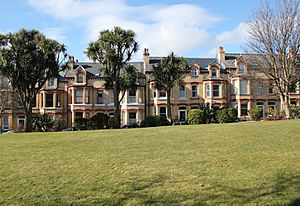Gerhard Bersu facts for kids
Quick facts for kids
Gerhard Bersu
|
|
|---|---|
| Born | September 26, 1889 Jauer, Silesia, Germany
|
| Died | November 19, 1964 (aged 75) Magdeburg, Germany
|
| Nationality | German |
| Occupation | Archaeologist |
| Organization | German Archaeological Institute |
| Spouse(s) | Maria Bersu |
Gerhard Bersu (born September 26, 1889 – died November 19, 1964) was an amazing German archaeologist. He traveled and dug up ancient sites all over Europe. Sadly, he had to leave Germany in 1937 because of unfair anti-Jewish laws during the time of Nazi Germany. During World War II, he was held on the Isle of Man. Even there, he made important discoveries, like a Viking boat burial site at Balladoole.
Contents
Early Life and Discoveries
Gerhard Bersu was born in Jauer, a place in Silesia, in 1889. His father was Jewish. From a young age, he loved prehistory, which is the time before written records. He started his archaeology journey while still in school! In 1907, he joined Carl Schuchhardt on digs near Potsdam.
Over the next few years, Bersu explored many countries. He dug in France, Switzerland, Italy, and Greece. He even worked with Hubert Schmidt at the Cucuteni site in Romania.
During World War I, he helped protect historical sites and collections on the Western Front. After the war, he worked with German groups dealing with peace agreements.
In 1924, Bersu joined the German Archaeological Institute in Frankfurt. By 1928, he became the Second Director. He helped the institute get new buildings. In 1931, he became the Director. Under his leadership, the institute became a place where archaeologists from all over Europe came together to share ideas.
However, after the Nuremberg Laws were passed in 1935, Bersu was forced to leave his director role. This was because of his Jewish background. He was given a lower job at the institute, but then had to retire completely later that year.
Digging at Little Woodbury
After losing his job and facing unfair laws in Germany, Bersu and his wife moved to Britain in 1937.
A British archaeologist named Osbert Crawford invited Bersu to dig. In 1938 and 1939, Bersu worked at Little Woodbury in Wiltshire. He brought new digging methods from Europe to Britain. This site was first spotted from an airplane as a crop mark (a pattern in crops that shows hidden ancient structures). But Bersu's work showed how important it truly was.
Bersu's careful way of digging was groundbreaking for England at that time. His work helped change old ideas about the British Iron Age. Before his digs, people thought Iron Age people lived in holes in the ground. This was because they found dug pits at similar sites. But Bersu found cereal grains and animal bones in these pits. This showed they were actually storage pits for food! He also found large postholes. These were holes where wooden posts once stood. This discovery helped Bersu convince British archaeologists that people lived in big Iron Age roundhouses. He even found one of these houses at the site.
Bersu also taught new ways of digging trenches. He also showed how to study the remains of timber posts. These posts were some of the only parts left of the ancient homes.
Life During Internment

When World War II started, Bersu and his wife were held on the Isle of Man. They were called "enemy aliens" because they were German-born. At first, they were separated. Maria was at Rushen Camp, and Bersu was at Hutchinson Internment Camp in Douglas. They didn't even know where the other was! But in October 1940, they were reunited. Married couples were allowed to meet. Later, they could live together at Rushen Camp. This was the only internment camp in Europe for married couples during the war.
Basil Megaw, who was the director of the Manx Museum, quickly saw how useful Bersu could be. He wanted Bersu to explore ancient sites on the Isle of Man. Bersu's friends and fellow archaeologists, like Gordon Childe, worked hard to get permission for him to dig.
Bersu was allowed to continue his research. Other people held in the camp helped him. His wife, Maria, did a lot of the important recording work. They dug at several old sites from the prehistoric and Viking ages. They made important finds at Chapel Hill at Balladoole, Ballanorris, Ronaldsway, and Ballacagan.
At Balladoole, Bersu thought he would find an Iron Age hill fort. Instead, he found much more! He discovered very old Mesolithic remains (from the Middle Stone Age). He also found a Bronze Age cist (a stone box for burial). There was also a Christian keeill (a small chapel) and a Christian burial ground. And, most excitingly, a Viking Age boat burial! They also found additional human remains at Ballateare and Balladoole.
Most of Bersu's digs on the Isle of Man were near public transport. This was because he and the other internees did not have cars. He used fellow internees to help him dig. Even though armed guards were present, they couldn't use pickaxes. Instead, they had to dig carefully with small trowels.
Bersu and his wife stayed on the Isle of Man after the war ended. They continued digging until 1947.
Later Years and Legacy
After the war, Bersu was offered a job at the Royal Irish Academy in Dublin. He stayed there until 1950. Then, he returned to Germany. He took up his old job at the German Archaeological Institute. He continued his work until he retired in 1956.
In 1947, Bersu also dug at a settlement called Green Craig in Creich, Fife.
Gerhard Bersu passed away suddenly in 1964. He was attending a meeting of the German Academy of Sciences in Magdeburg at the time. His work greatly influenced how archaeologists study ancient sites, especially in Britain.


